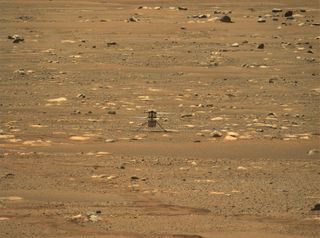
NASA is already working to map out the bright exploration future opened up by its little Mars helicopter.
The 4-lb. (1.8 kilograms) chopper, known as Ingenuity, aced a 39-second hover above the floor of Mars' Jezero Crater on Monday morning (April 19), becoming the first aircraft ever to perform a powered, controlled flight on a world beyond Earth.
Ingenuity is a technology demonstration designed to help pave the way for bigger, more complex and more capable craft down the road — and mission team members are already thinking about what those future Mars helicopters might look like.
Video: Watch Ingenuity's first flight on Mars
"The fundamental dynamics of these vehicles does scale up to very reasonable sizes, so we are thinking of things in the 25- to 30-kilogram [55 to 66 lbs.] class," Ingenuity chief engineer Bob Balaram, of NASA's Jet Propulsion Laboratory (JPL) in Southern California, said during a postflight news conference Monday.
"Early design work on that has started, too, with conceptual design and to see what would it take to deploy these and operate them," he added.
More flying to come
Ingenuity landed in Jezero aboard NASA's Perseverance rover on Feb. 18 and deployed from the six-wheeled robot's belly six weeks later.
Get the Space.com Newsletter
Breaking space news, the latest updates on rocket launches, skywatching events and more!
That milestone started the clock ticking on Ingenuity's month-long flight window. That deadline is non-negotiable, because Perseverance needs to start focusing on its own science work, which centers on the hunt for signs of ancient Mars life and the collection of samples for future return to Earth. (The car-sized rover is currently observing and supporting Ingenuity's flight campaign; all communications to and from the little chopper are routed through Perseverance.)
The Ingenuity team hopes to squeeze four more flights into the two weeks that the 19-inch-tall (48 centimeters) helicopter has left. These flights — the next of which could lift off as early as Thursday (April 22) — will get successively more ambitious.
"This is a pathfinder," Ingenuity project manager MiMi Aung, also of JPL, said during Monday's news conference. "We really want to know what the limits are, so we will be pushing the limits very deliberately."
Ingenuity carries a black-and-white navigation camera and a 13-megapixel color imager but no scientific instruments. Its envisioned descendants will be quite scientifically capable, however; Balaram said that the larger chopper he and his team are imagining could likely carry about 10 lbs. (4.5 kg) of research gear.
But don't hold out hope for a chopper capable of a much heavier scientific lift.
For "anything much larger, the packaging of the blades and things becomes quite awkward so may not be quite feasible in the near term," Balaram said. "But definitely, something in the 50-pound class, compared to our little 4-pound Ingenuity, is definitely something that's very feasible. And there's actually some early progress that has been made in that direction."
Related: Arnold Schwarzenegger tells NASA to 'Get to the choppa!'
Other worlds to explore
Such early progress will lead to helicopters becoming a common part of Mars exploration, if all goes according to NASA's plans. Red Planet choppers could serve as scouts for rovers and gather scientific data on their own in hard-to-reach places such as cliff faces, agency officials have said.
That future is still quite hazy; NASA has not yet approved any additional Mars helicopter missions. But the agency is officially developing a rotorcraft mission to a different alien world — Saturn's giant moon Titan, which is widely regarded as one of the solar system's best bets to host life beyond Earth.
That mission, called Dragonfly, will send a 10-foot-long (3 meters) drone to study Titan's complex chemistry up close and in detail. The rotorcraft is scheduled to launch in 2027 and land on the 3,200-mile-wide (5,150 kilometers) moon in 2036. Dragonfly will then make several dozen flights through Titan's hazy skies, performing its scientific work in many different locations. (Titan's atmosphere is far thicker than that of Mars, so flying there is much easier.)
Ingenuity's efforts on Mars will help Dragonfly and any other rotorcraft that launch toward other worlds, Balaram said.
"The bigger lesson here, I think, is also, How do we operate these vehicles? How do we test these vehicles?" he said. "So, there is that kind of knowledge that we have learned from this process of flying Ingenuity that will definitely transfer over and be useful for the folks who will be considering missions to those [other] places."
Mike Wall is the author of "Out There" (Grand Central Publishing, 2018; illustrated by Karl Tate), a book about the search for alien life. Follow him on Twitter @michaeldwall. Follow us on Twitter @Spacedotcom or Facebook.
Join our Space Forums to keep talking space on the latest missions, night sky and more! And if you have a news tip, correction or comment, let us know at: community@space.com.

Michael Wall is a Senior Space Writer with Space.com and joined the team in 2010. He primarily covers exoplanets, spaceflight and military space, but has been known to dabble in the space art beat. His book about the search for alien life, "Out There," was published on Nov. 13, 2018. Before becoming a science writer, Michael worked as a herpetologist and wildlife biologist. He has a Ph.D. in evolutionary biology from the University of Sydney, Australia, a bachelor's degree from the University of Arizona, and a graduate certificate in science writing from the University of California, Santa Cruz. To find out what his latest project is, you can follow Michael on Twitter.
